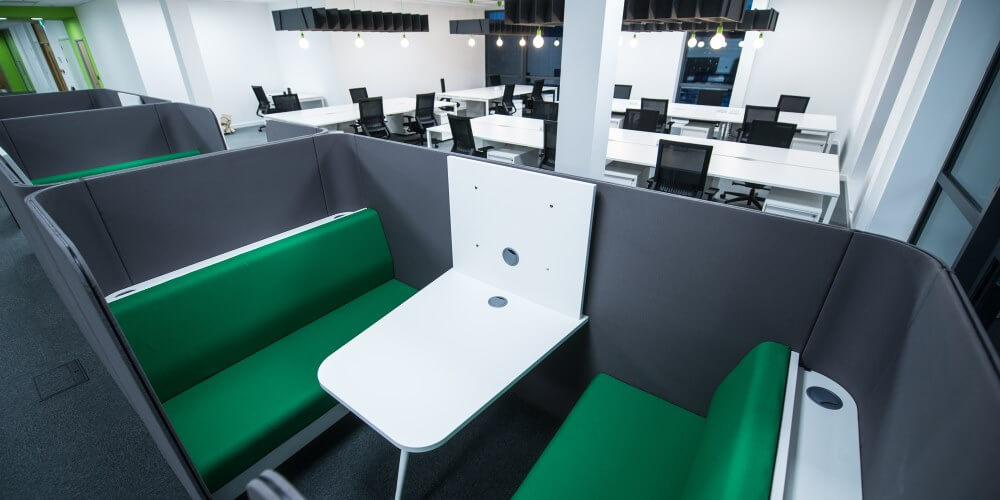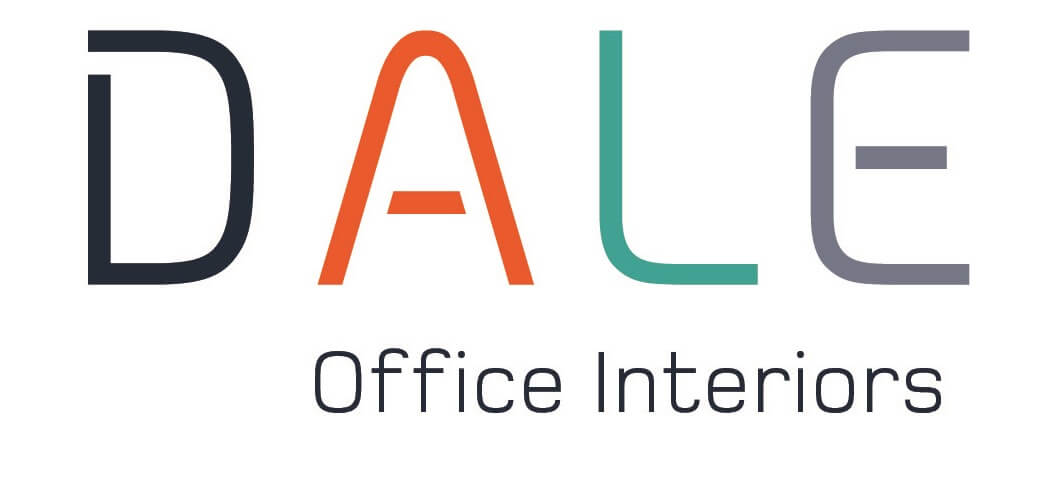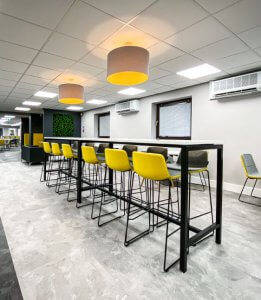Open-plan offices have had mixed reviews in the past as numerous studies show they can be bad for our health and productivity.
Despite the negativity, over 8 million UK employees work in open-plan environments so this type of office is very much the norm for many British workers.
Below, we take a look at the pros and cons of open-plan offices and how – with the right design – they can be healthy, productive and enjoyable places to work.
An open-plan office is a workspace that has minimum enclosed spaces, such as private offices.
Employees share the same space to work in, which can include desks, meeting spaces and areas for socialising.
Pros
Collaboration
Open-plan environments can create unique opportunities for collaboration – from problem solving to creative idea sessions – which can actually aid productivity and engagement. Ad-hoc discussions and ideas sharing can reduce the need for more formal time-consuming meetings.
What to do:
- For smooth collaboration, position employees who support each other in close proximity. For example, technical teams could work alongside creatives or sales teams could work beside the marketing department.
- Create different work spaces of varying sizes for collaboration to really flourish. This includes private spaces for one or two people. Often during an ideas session, teams will meet up on mass, then break off into smaller groups, or individually, to develop ideas.

Gordons LLP
Communication
Removing physical barriers in an office means employees can speak openly with each other, without the need for phone calls, emails or formal meetings.
Open offices often mean that employees of all levels work alongside each other, this can make managers or members of the c-suite much more approachable and keep them up to speed with what’s happening in their company.
What to do:
- Focus on creating flexible spaces that encourage teams to interact and communicate. Bear in mind that some teams don’t need to communicate as readily as others and may benefit more from working in quieter spaces.
- A well-designed open office will encourage employees to move around more and speak to people directly instead of relying on internal email and phone calls. One study revealed that implementing an open office meant the number of emails being sent dropped by more than 50%, while decision making accelerated by 25%.
Thinking about a new design for your office but don’t know where to start? Download your free guide here.

Flexibility and futureproofing
Open-plan office designs are a lot more agile than offices with private rooms or fixed partitions. Therefore an open-plan space can be adapted to grow with your business as the company’s needs change.
Successful designs provide a variety of spaces for employees to work in so they have the most appropriate set up for their individual requirements.
What to do:
- Provide a range of spaces and equipment for employees to use. This could include modular furniture that can be reconfigured easily, access to the right technology to allow easy set-up and private booths for phone calls or focused work.
- Allow employees to choose where they work – this can actually improve their overall workspace satisfaction.

Badgequo
Cons
Productivity
Distractions and disruptions are key downsides of open-plan offices that are regularly cited in studies. According to one study, employees working in an open-plan office lose 86 minutes a day to distractions. Even brief interruptions can lead to employees making errors.
With the right design, open-plan offices can actually aid productivity by providing a variety of workspaces to suit the different working requirements for individual employees.
What to do:
Privacy
Lack of privacy is a notorious problem in open-plan offices and can be costly – on average office workers lose 28% of their productive time to distractions. Thankfully, contemporary open-plan office design takes this into account. Managers have realised that working in isolation is sometimes necessary to give employees the space to concentrate and fully immerse themselves in a task.
Privacy from stimulation gives employees the space to work (or simply ‘be’) away from noise and distractions.
What to do:
- Introduce ‘noise guidelines’ for employees that cover what is and isn’t acceptable in terms of distractions. This could include employees needing to use headphones when listening to videos or office-wide music only being played at certain times.
- Provide employees with a space to take personal or sensitive phone calls or to have confidential meetings with other members of the team.
- Design private workspaces within the open-plan office for people to work individually, by creating designated quiet spaces in the form of booths or pods that keep sound to a minimum.

Zoo Digital
Health
According to research, 90% of employees who work in open-plan offices experience “high levels of stress, conflict (and) high blood pressure”. Open-plan offices have also been cited as the reason for increased number of sick days, with employees in this type of office having 62% more days off sick, due to a large number of employees working together in close proximity.
The noise in open-plan offices can cause stress levels to rise, with one study showing that working in a noisy office can increase levels of adrenaline.
What to do:
- Allow employees to wear noise-cancelling headphones.
- Create ‘quiet zones’ within the office where areas can be sectioned off for individuals to work away from colleagues, phones and other audial distractions.
- Integrate features that promote calm such as appropriate lighting, biowalls or water features.










